The Intel Haswell-E CPU Review: Core i7-5960X, i7-5930K and i7-5820K Tested
by Ian Cutress on August 29, 2014 12:00 PM ESTCPU Benchmarks
The dynamics of CPU Turbo modes, with both Intel and AMD, can cause concern during environments with a variable threaded workload. There is also an added issue of the motherboard remaining consistent, depending on how the motherboard manufacturer wants to add in their own boosting technologies over the ones that the CPU manufacturer would prefer they used. In order to remain consistent, we implement an OS-level unique high performance mode on all the CPUs we test which should override any motherboard manufacturer performance mode.
HandBrake v0.9.9: link
For HandBrake, we take two videos (a 2h20 640x266 DVD rip and a 10min double UHD 3840x4320 animation short) and convert them to x264 format in an MP4 container. Results are given in terms of the frames per second processed, and HandBrake uses as many threads as possible.
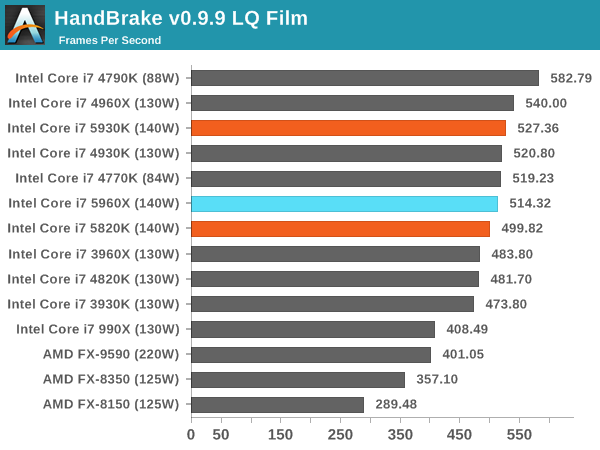
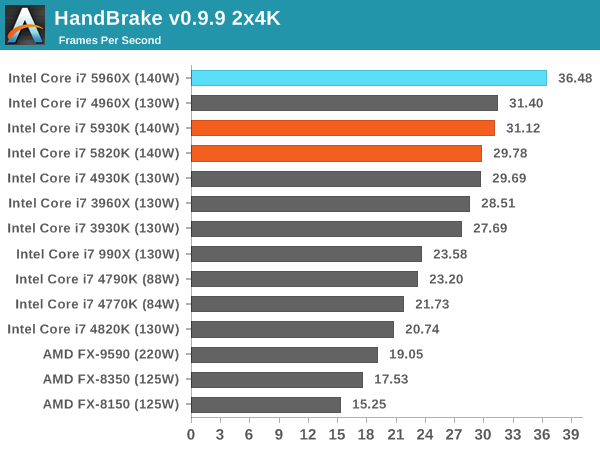
The variable turbo speeds of the CPUs results in a small difference in low quality conversion, and the high single core frequency of the 4790K wins there. For 4K conversion the problem becomes more parallel and the extra cores of the 5960X push it ahead of the pack. The 5930K and 5820K are both behind the 4960X however.
Agisoft Photoscan – 2D to 3D Image Manipulation: link
Agisoft Photoscan creates 3D models from 2D images, a process which is very computationally expensive. The algorithm is split into four distinct phases, and different phases of the model reconstruction require either fast memory, fast IPC, more cores, or even OpenCL compute devices to hand. Agisoft supplied us with a special version of the software to script the process, where we take 50 images of a stately home and convert it into a medium quality model. This benchmark typically takes around 15-20 minutes on a high end PC on the CPU alone, with GPUs reducing the time.
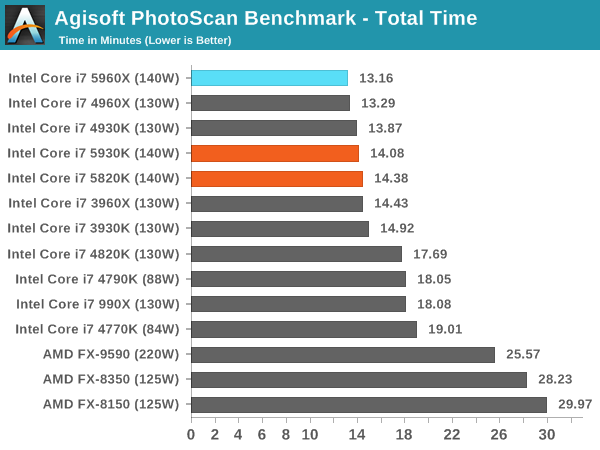
Photoscan's four separate components rely on different amounts of high frequency vs. many cores: check our Bench database for more detailed results but overall the 5960X comes out on top. That being said, the 5820K is less than 40% of the price and is only 1.2 minutes behind.
Dolphin Benchmark: link
Many emulators are often bound by single thread CPU performance, and general reports tended to suggest that Haswell provided a significant boost to emulator performance. This benchmark runs a Wii program that raytraces a complex 3D scene inside the Dolphin Wii emulator. Performance on this benchmark is a good proxy of the speed of Dolphin CPU emulation, which is an intensive single core task using most aspects of a CPU. Results are given in minutes, where the Wii itself scores 17.53 minutes.
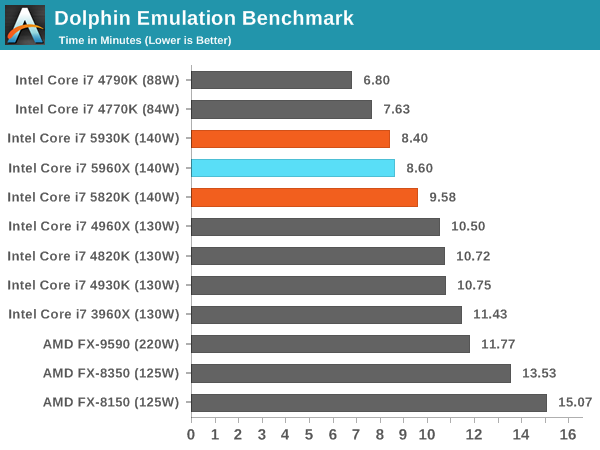
Dolphon loves single core speed and efficiency, meaning the 4790K wins out again. Interestingly the large L3 cache of the 5960X also helps here against the 5820K, despite the 5820K having a higher single thread frequency.
WinRAR 5.0.1: link
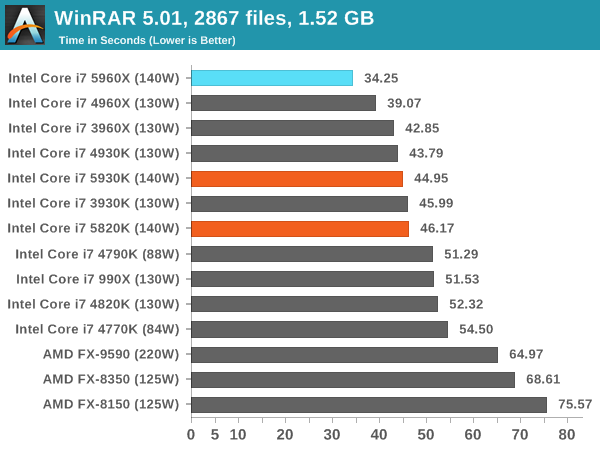
WinRAR is a variable thread workload, but more cores still wins out. Interestingly the xx60X CPUs are ahead of the xx30K CPUs followed by the xx20K. After this comes the 4790K, and then the 990X on par, showing how far three generations of Intel CPU have developed.
PCMark8 v2 OpenCL
A new addition to our CPU testing suite is PCMark8 v2, where we test the Work 2.0 and Creative 3.0 suites in OpenCL mode.
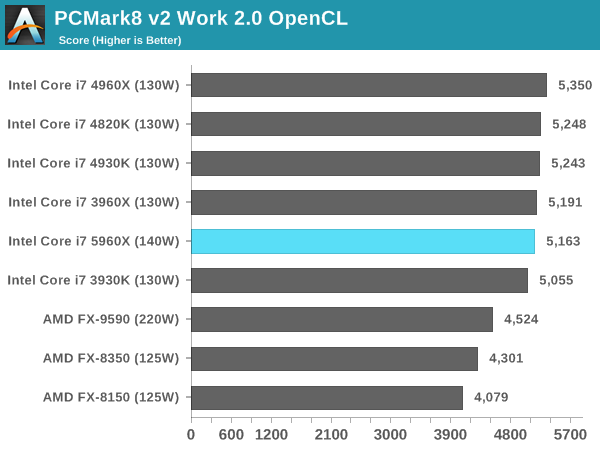
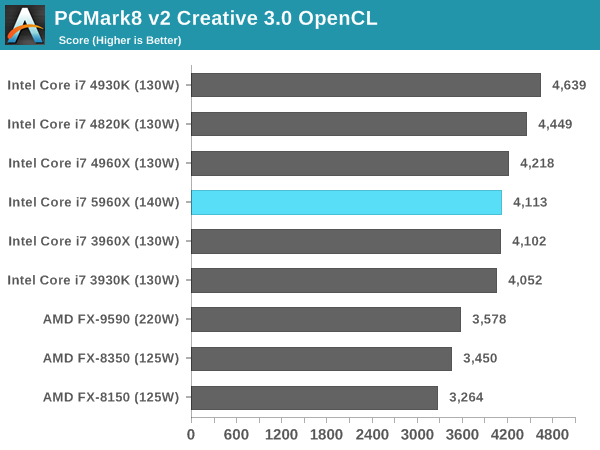
PCMark v8 relies on a number of factors, and it would seem that frequency is preferred over cache and memory. Interestingly the 4930K beat the 4960X in the Creative Suite with no obvious explanation.
Hybrid x265: link
Hybrid is a new benchmark, where we take a 4K 1500 frame video and convert it into an x265 format without audio. Results are given in frames per second.

Converting 4K video gets another step in the preference for more cores in Hybrid x265. The 5820K matches the 3960X, showing the progression of CPU generational development.
Cinebench R15
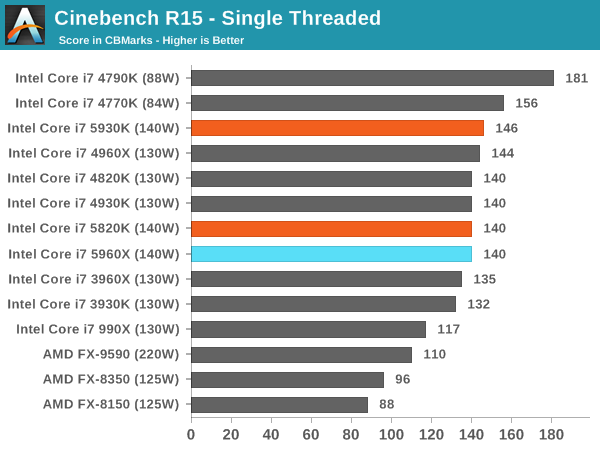
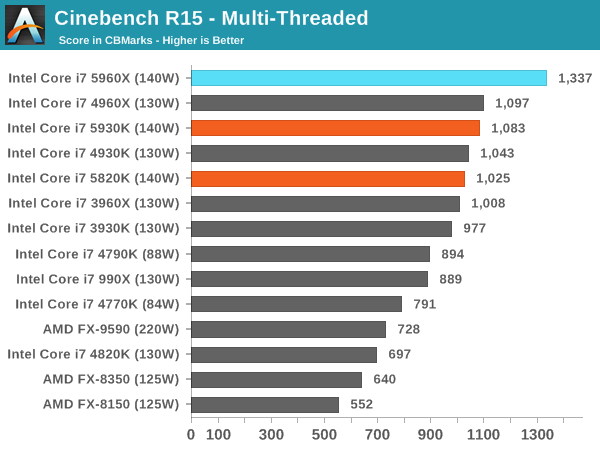
3D Particle Movement
3DPM is a self-penned benchmark, taking basic 3D movement algorithms used in Brownian Motion simulations and testing them for speed. High floating point performance, MHz and IPC wins in the single thread version, whereas the multithread version has to handle the threads and loves more cores.
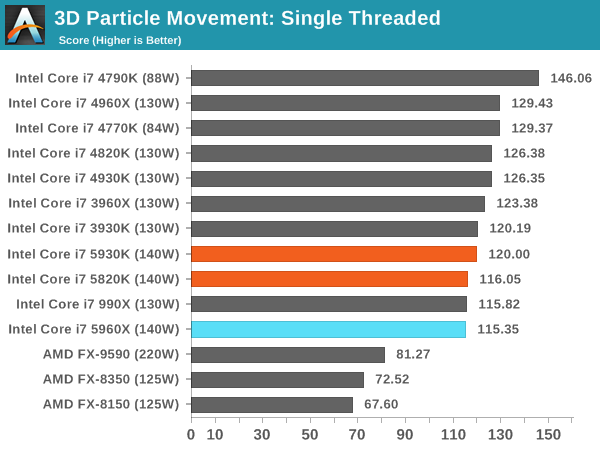

FastStone Image Viewer 4.9
FastStone is the program I use to perform quick or bulk actions on images, such as resizing, adjusting for color and cropping. In our test we take a series of 170 images in various sizes and formats and convert them all into 640x480 .gif files, maintaining the aspect ratio. FastStone does not use multithreading for this test, and results are given in seconds.
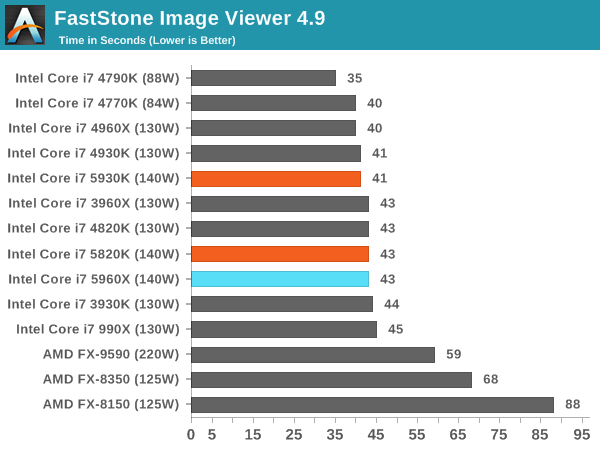
FastStone is a purely single threaded exercise, showing here how the lower core CPUs with high turbo perfom best, and by quite a margin.










203 Comments
View All Comments
jabber - Saturday, August 30, 2014 - link
At the end of the day the Xeons are just bug fixed lower power i7 chips anyway. But one way that Xeons come into their own is on the second hand market. I'll be picking up ex. corp dual CPU Xeon workstations for peanuts compared to the domestic versions. I have a 7 year old 8 core Xeon workstation that still WPrimes in 7 seconds. Not bad for a $100 box.mapesdhs - Saturday, August 30, 2014 - link
All correct, though it concerns me that the max RAM of X99 may only be 64GB much
of the time. After adding two cores and moving up to working with 4K material, that's
not going to be enough.
Performance-wise, good for a new build, but sadly probably not good enough as an
upgrade over a 3930K @ 4.7+ or anything that follows. The better storage options
might be an incentive for some to upgrade though, depending on their RAID setups
& suchlike.
Ian.
leminlyme - Tuesday, September 2, 2014 - link
They are applicable to different crowds, and computing doesn't exclude gaming, whereas Xeons to a degree do (Though I'm sure for most of them you'd be fine, I for one like those PCI lanes, as well as the per core performance on the desktop processors is just typically better. Plus form factor and all that. These fill a glorious niche that I am indeed excited about. They're pretty damn cheap for their quality too. I guess the RAM totally circumvents that benefit though.Mithan - Friday, August 29, 2014 - link
I am into gaming and nothing is worth upgrading over the 2500 if you have it. For you it's different of course :)AnnihilatorX - Saturday, August 30, 2014 - link
I am thinking of upgrading my 2500 k actually, because I got a dud CPU which won't even overclock to 4.2Ghzmindbomb - Friday, August 29, 2014 - link
That's the fault of the software. Seems unfair to blame the chip for that. DX12 should change that anyway.CaedenV - Friday, August 29, 2014 - link
How exactly will DX12 help? DX12 is good for helping wimpy hardware move from horrible settings to acceptable settings, but for the high end it will not help much at all. Beyond that, it helps the GPU be more efficient and will have little effect on the CPU. Even if it did help the CPU at all, take a look at those charts; pretty much every mid to high end CPU on the market can already saturate a GPU. If the GPU is already the bottle neck then improving the CPU does not help at all.iLovefloss - Friday, August 29, 2014 - link
DirectX12 promises to make more efficient use of multicore processors. AnandTech has already did a piece on Intel's demonstration of its benefit.bwat47 - Sunday, August 31, 2014 - link
I'm sick of hearing this nonsense. Even with reasonably high end hardware mantle and DX12 can help minimum framerates and framerate consistency considerably. I have a 2500k and a 280x, and when I use mantle I get a big boost in minimum framerate.The3D - Friday, September 12, 2014 - link
Given the yet to be released directx 12 and the overall tendency to have less cpu intensive graphics directives ( mantle) i guess the days in which we needed extra powerful cpus to run graphic intensive games are coming to an end.